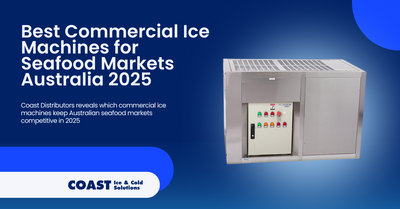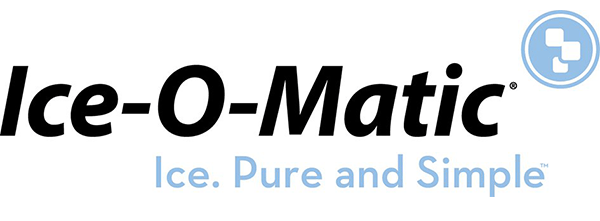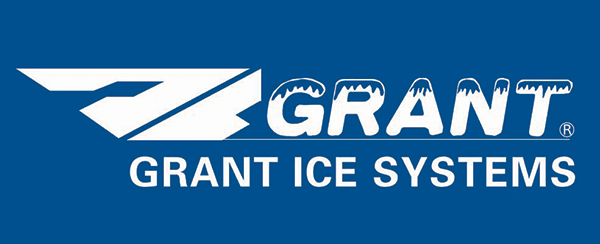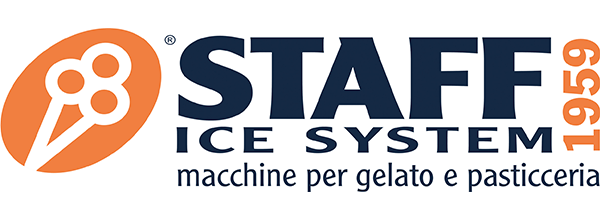Best Commercial Ice Machines for Seafood Markets Australia 2025
The Coast Team on 10th Jun 2025
The distinction between a thriving seafood market and one struggling to maintain quality often comes down to a single factor: ice technology. In Australia's demanding coastal environments, where premium seafood commands top dollar and reputation drives repeat business, selecting the right commercial ice equipment represents a critical business decision.
After decades supplying ice machines to seafood markets from Eden to Exmouth, Coast Distributors has witnessed the evolution of refrigeration technology and the increasing demands placed on commercial operators. The standards required in 2025 extend far beyond simple ice production – encompassing food safety compliance, energy efficiency, and the ability to withstand harsh coastal conditions.
Understanding Seafood Market Ice Requirements
Seafood preservation demands precision that general foodservice operations rarely encounter. The window between optimal freshness and quality degradation measures in hours, not days. Temperature fluctuations of even a few degrees accelerate bacterial growth and tissue breakdown, directly impacting both safety and marketability.
Australian seafood markets operate under increasingly stringent regulations. Food Standards Australia New Zealand (FSANZ) guidelines require maintaining the cold chain from catch to consumer. This means consistent temperatures below 5°C, with many operators targeting 0-2°C for premium products. Achieving these temperatures requires more than basic refrigeration – it demands the right type and volume of ice, properly applied and maintained.
The economics are straightforward: insufficient or improper ice coverage leads to product loss. A single spoiled batch of prawns or degraded sashimi-grade tuna can cost thousands in direct losses and immeasurable damage to reputation. Conversely, proper ice equipment investment pays dividends through reduced waste, extended shelf life, and the ability to command premium prices for consistently fresh products.
The Science of Flake Ice for Seafood Applications
Not all ice serves seafood markets equally. While cube ice might suffice for beverage service, seafood preservation demands flake ice's unique properties. The science behind this preference relates to heat transfer efficiency and product protection.
Flake ice's thin, flat profile maximises surface contact with products, creating rapid and uniform cooling. Unlike cube ice that creates point contact and potential bruising, flake ice moulds gently around delicate seafood, providing complete coverage without damage. The subcooled temperature – typically -7°C to -9°C – provides superior cooling reserve compared to standard ice at 0°C.
The Grant Sub Zero Flake Ice Machines exemplify purpose-built seafood market solutions. These systems produce consistent flake ice at -9°C, providing the cooling power necessary for maintaining optimal product temperatures even during extended display periods. The static vertical evaporator design ensures reliability and minimal maintenance – critical factors for operations that cannot afford downtime.
Capacity Planning for Australian Seafood Markets
Determining appropriate ice production capacity requires careful analysis of operational patterns. Seafood markets experience significant demand fluctuations – from quiet midweek periods to frantic holiday weekends. Undersizing equipment leads to scrambling for supplemental ice during peak periods, while oversizing increases capital and operating costs unnecessarily.
Many operators find success by calculating their peak daily requirements and adding substantial buffer capacity. Based on our experience, medium-sized seafood markets typically utilise significant ice volumes daily, with larger operations requiring substantially more during peak periods. The Grant FFAR Series offers scalable solutions, with models ranging from 400kg to 5000kg daily production.
For operations requiring substantial volume, the Grant FF2.5E delivers up to 2500kg of flake ice per 24 hours. This evaporator-only model suits contractors combining multiple units on common refrigeration plants, providing flexibility for expanding operations. The advanced D-shaped stainless steel coil design improves refrigerant flow and reduces energy consumption – critical considerations given rising electricity costs.
Storage capacity proves equally important. Ice production doesn't always align with usage patterns. Adequate storage bins allow overnight accumulation for morning rush periods and provide buffer capacity for equipment maintenance windows. Matching storage to production capacity ensures consistent ice availability throughout trading hours.
Alternative Ice Solutions for Specific Applications
While flake ice remains the gold standard for direct seafood contact, certain applications benefit from alternative ice types. Pre-chilling storage containers, maintaining cold rooms, and some display applications can utilise different ice forms effectively.
The Ice-O-Matic UCF165A represents a versatile option, producing up to 80kg of flake ice daily with 25kg storage capacity. This self-contained unit suits smaller operations or supplementary ice requirements. The front air ventilation design allows installation in tight spaces without compromising performance – valuable in cramped market environments.
For high-volume supplementary ice needs, the Ice-O-Matic MFI1255A modular flake ice maker produces up to 572kg daily. While not producing the subcooled flake ice of Grant systems, these units provide reliable bulk ice for applications where extreme cold temperatures aren't critical.
Addressing Coastal Environment Challenges
Australian coastal environments present unique challenges for commercial refrigeration equipment. Salt air accelerates corrosion, high humidity affects performance, and temperature extremes stress components. Equipment designed for inland applications often fails prematurely in coastal settings.
Quality seafood market ice machines incorporate specific features for environmental resilience. Stainless steel construction – particularly 304-grade for evaporators and food zones – resists corrosion. Sealed electrical components prevent salt air infiltration. Enhanced condenser coatings protect against coastal conditions.
Ventilation requirements become critical in humid coastal environments. Insufficient airflow leads to reduced ice production, increased energy consumption, and premature component failure. Professional installation ensuring adequate clearances and air circulation paths proves essential for achieving rated capacities and equipment longevity.
Regular maintenance takes on increased importance in coastal settings. Salt accumulation on condensers reduces efficiency and accelerates wear. Monthly condenser cleaning, quarterly comprehensive inspections, and annual deep maintenance help combat environmental challenges. Establishing preventive maintenance contracts ensures consistent attention to these requirements.
Water Treatment: The Foundation of Quality Ice
Australian water quality varies dramatically by location, with many coastal areas presenting significant challenges. High mineral content, chlorination, and seasonal variations all impact ice quality and equipment longevity. Proper water treatment isn't optional – it's fundamental to successful operation.
The CD20B High Capacity Water Filter System suits most seafood market applications. This system reduces sediment, chlorine, and scale-forming minerals while maintaining the flow rates necessary for commercial ice production. The triple-action filtration addresses taste, odour, and equipment protection simultaneously. Find this and other filtration solutions at Coast Parts.
For locations with extreme water quality challenges, the CD40B Twin System provides enhanced protection. The series configuration allows customisation for specific water conditions – combining sediment pre-filtration with scale inhibition and taste/odour reduction. This flexibility proves valuable given Australia's diverse water conditions. Browse the complete range of water filtration systems at Coast Parts.
Regular filter replacement maintains protection levels. High-sediment locations may require quarterly changes, while better water quality might allow six-month intervals. Monitoring pressure drop across filters indicates loading levels and replacement timing. The investment in quality filtration pays returns through extended equipment life and consistent ice quality.
Installation Best Practices for Seafood Markets
Professional installation determines long-term equipment performance. Seafood markets present specific challenges: wet environments, space constraints, hygiene requirements, and operational workflow considerations. Cutting corners during installation invariably leads to operational problems and premature failures.
Drainage represents a critical consideration. Seafood markets already manage significant water volumes from cleaning and product handling. Ice machine drainage must integrate properly with existing systems while preventing backflow contamination. Floor drains require adequate capacity and proper trapping to handle ice melt without creating slip hazards.
Electrical infrastructure often requires upgrading for larger ice machines. Three-phase power provides efficiency advantages for high-capacity units but may necessitate electrical service modifications. Dedicated circuits prevent overloading and ensure consistent operation. Ground fault protection becomes essential in wet environments.
Location planning impacts both efficiency and workflow. Positioning equipment for easy access facilitates maintenance while considering traffic patterns prevents congestion during busy periods. Noise considerations matter too – some machines generate significant sound levels that prove disruptive in retail environments.
Financial Considerations and ROI Analysis
Quality ice equipment represents significant capital investment. However, comprehensive financial analysis reveals compelling returns when considering total operational impact. The calculation extends beyond simple purchase price comparisons to encompass energy efficiency, maintenance costs, product loss prevention, and revenue opportunities.
Energy consumption varies dramatically between equipment grades. Premium units incorporating efficient compressors and optimised refrigeration cycles can reduce operating costs by typically 20-30% compared to basic models. Over a typical 10-year lifespan, these savings often exceed the initial price premium.
Product preservation improvements translate directly to bottom-line results. Even modest reductions in spoilage through better ice coverage and temperature control can generate substantial savings for medium-sized operations. Additionally, consistent quality enables premium pricing – customers willingly pay more for demonstrably fresh products.
Downtime costs often surprise operators. A failed ice machine during peak summer trading can cost thousands in lost sales and emergency ice purchases. Quality equipment with local service support minimises these risks. Coast Distributors' 24-hour service capability ensures rapid response when problems arise.
Making the Right Choice for Your Operation
Selecting appropriate ice equipment requires honest assessment of current needs and future growth plans. Consider peak capacity requirements, not average demand. Factor in market positioning – premium seafood demands premium presentation and preservation. Evaluate site-specific challenges like water quality and environmental conditions.
For small to medium operations, the Grant FF1AR self-contained unit producing up to 1000kg daily provides an excellent starting point. Larger markets benefit from modular systems allowing staged capacity increases. Multi-site operations should consider standardising equipment for maintenance efficiency and parts inventory management.
The Path Forward
Australian seafood markets face increasing competition from supermarket chains and online sellers. Success requires differentiating through quality, presentation, and customer experience. Professional-grade ice equipment forms the foundation for maintaining the product quality that keeps customers returning despite convenient alternatives.
Investment in proper ice-making technology pays dividends through reduced waste, energy savings, compliance assurance, and enhanced reputation. The question isn't whether quality equipment justifies its cost – it's whether your operation can afford the hidden costs of inadequate ice solutions.
Ready to upgrade your seafood market's ice production capabilities?
Coast Distributors brings unmatched expertise in commercial ice solutions for Australian seafood markets. Our comprehensive range includes everything from compact supplementary units to high-volume production systems designed for coastal environments.
Take action today:
- Browse our complete range of Grant flake ice machines engineered specifically for seafood preservation
- Explore water filtration solutions and spare parts at Coast Parts to protect your investment and ensure optimal ice quality
- Contact our expert team through our contact form for personalised recommendations based on your specific requirements
- Request immediate service support via our service request form for existing equipment
Don't let inferior ice equipment compromise your seafood quality and reputation. Partner with Coast Distributors to implement professional ice solutions that support your business growth and profitability.
Coast Distributors is Australia's trusted commercial ice equipment specialist, providing comprehensive solutions for seafood markets nationwide. With extensive technical expertise and 24-hour service support, we ensure your operation maintains optimal performance year-round.









